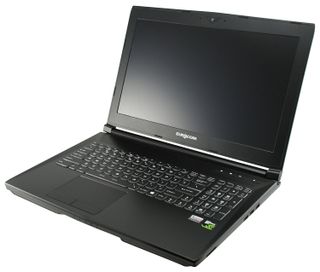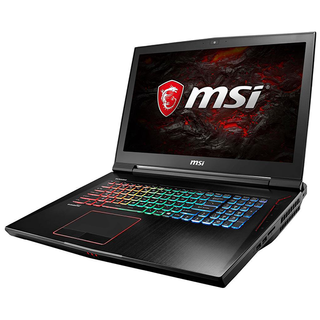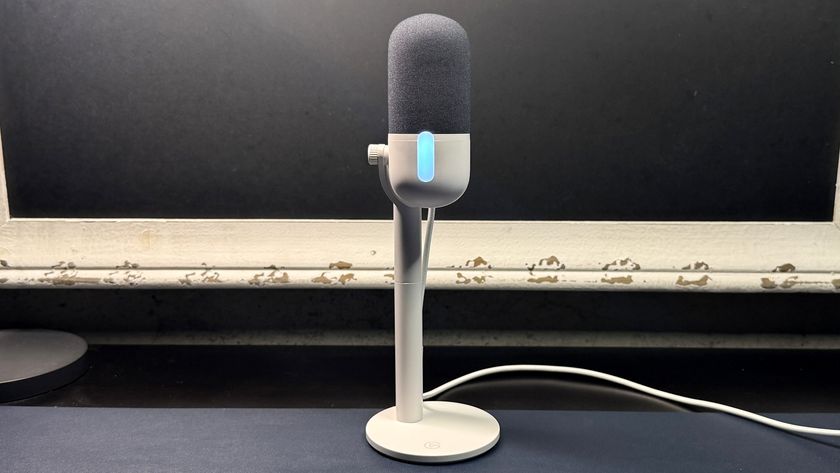Asus ROG Zephyrus Max-Q Gaming Laptop Review
Why you can trust Tom's Hardware
Synthetic Benchmarks
The Asus ROG Zephyrus has wowed us so far in presentation. Let's move on to performance. This laptop features a 7th-generation Intel Core i7-7700HQ, Nvidia’s new GeForce GTX 1080 with Max-Q design, 24GB of DDR4-2400 memory, and a 512GB M.2 SSD. It has a 15.6” Full HD (1920x1080) anti-glare IPS display with G-Sync technology, and it runs at 120Hz. Also note, considering its size, the Zephyrus doesn’t have a 1TB HDD, which is standard on most gaming laptops.
Unfortunately, we haven’t tested a GTX 1080-based laptop with an i7-7700HQ, so we can’t quite make a 1:1 Max-Q vs. non-Max-Q comparison. Instead, we chose laptops that we felt came the closest in terms of specifications. Now for the competition.
The recently reviewed Alienware 15 aims at a similar price bracket, albeit with a GTX 1070. It features an i7-7700HQ, 16GB of DDR4-2400 memory, a 256GB M.2 SSD for its operating system, and a 1TB 7200RPM HDD for additional storage. It also has a 15.6” FHD matte IPS display with G-Sync and a 120Hz refresh rate; the Alienware’s display is rated at 400 nits of brightness.
If you’re looking for bigger guns, the MSI GT73VR Titan SLI 4K has them. It has an overclockable i7-7820HK, as well as two GeForce GTX 1070s running in SLI. It also has 32GB of DDR4-2400, two 256GB M.2 SSDs running MSI's Super RAID technology, and a separate 1TB 7200RPM drive for additional storage. As the name suggests, it has a 17.3" Ultra HD (3840x216) matte IPS display.
Finally, we’ve included the results for our upcoming Eurocom Tornado F5, which features a non-Max-Q GTX 1080. It's equipped with a desktop Intel Core i7-7700K, 16GB of DDR4-2400 memory, a 250GB M.2 SSD, and a 1TB 7200RPM HDD for additional storage. The Tornado F5 has a 15.6" Full HD (1920x1080) IPS display with a matte coating.
We've made some notes on the following page (gaming benchmarks) regarding our performance expectations, given Nvidia's guidance on Max-Q. But generally speaking, a Max-Q GPU's clock rate is less than that of a non-Max-Q GPU. Therefore we expect to see performance differences between the Asus Zephyrus and the Eurocom Tornado—in purely graphics-bound performance loads, the Zephyrus will perform within about 80% of the Eurocom laptop. In various other metrics, the Eurocom's stronger CPU also comes into play.
3DMark




3DMark is useful because it gives us a snapshot of what kind of gaming performance we should expect. The Asus ROG Zephyrus lands exactly where we expect it to, higher than the Alienware 15, but lower than the Eurocom Tornado F5. We were hoping for better results, but the Max-Q design limits the GTX 1080 clock rate a bit. The Eurocom has a desktop-class CPU, further widening the gap between the two, especially in the Physics tests.
Cinebench R15

Cinebench features single-core and multi-core rendering tests, measuring CPU performance, as well as the platform-based OpenGL shading test, which grants a slight edge to systems with apt GPU horsepower. Both the Zephyus and Alienware 15 feature a mobile i7-7700HQ processor, so their single-core and multi-core results are quite even. The Eurocom and MSI score much higher thanks to their stronger CPUs. However, the OpenGL results don’t shine the Zephyrus in the most positive light. It results in a 5% lower score than the Alienware laptop, despite the latter only having a GTX 1070.
CompuBench

CompuBench has a variety of workloads to choose from. We use the platform-based Video Processing test and a GPU-heavy Bitcoin Mining test. The Video Processing test illustrates the Asus Zephyrus outperforming the Alienware 15 and even the MSI Titan SLI, thanks to its more powerful GTX 1080 (the chosen workload doesn't support multi-GPU setups). The gap becomes even more apparent during Bitcoin Mining, with the Asus Max-Q GTX 1080 outperforming the MSI Titan SLI’s GTX 1070 by about 9%. However, the Eurocom isn’t bottlenecked by a mobile CPU, so it outperforms the Asus here by 13%.
IOMeter


We perform an IOmeter test on each laptop’s primary drive to measure basic random and sequential read and write speeds. The Zephyrus utilizes a 512GB Samsung SM961. The MSI Titan SLI also contains 512GB of SM951 storage, albeit using two 256GB models in a RAID 0 configuration. The Alienware also sources Samsung for its storage needs, but uses a 512GB PM961 instead. Finally, the Tornado F5 hosts a 250GB Samsung 960 EVO. This is essentially a battle of the Samsung SSDs.
The Zephyrus's SM951 exhibits decent 4K random speeds, though it isn't as as fast as the MSI's RAID configuration or the Eurocom's Samsung 960 EVO. However, the SM951 has the fastest 128K sequential read speed, so accessing larger files is in its wheelhouse. The MSI's two SM951s outperform it in 128K sequential write speed, however.
PCMark 8

PCMark 8 hosts home, creative, and office workloads, but if you have Microsoft Office and Adobe Creative installed on your system, you can utilize PCMark’s specialized Office and Creative tests, which will give you a better approximation of a system’s performance. The Tornado F5 has the superior CPU, so it outperforms our Zephyrus in Adobe Creative tasks, although by a small margin. The Zephyrus receives a boost from its extra 8GB of memory. The MSI Titan SLI’s extra GPU doesn’t offer much of a performance boost over the Alienware, so when faced with GTX 1080-based laptops, it falls behind. Still, the difference between these scores isn’t huge.
MORE: Best Gaming Laptops
MORE: Gaming Laptop Previews
MORE: All Laptop Content
Current page: Synthetic Benchmarks
Prev Page Introduction & Product Tour Next Page Gaming BenchmarksStay On the Cutting Edge: Get the Tom's Hardware Newsletter
Get Tom's Hardware's best news and in-depth reviews, straight to your inbox.
-
icepick314 I recently purchase Razer Blade Pro with 2TB SSD option. Even with slight discount at 5%, it still came out to $4655.Reply
It has touch screen 4K which is a nice addition and so far I can play most games in 4K with details toned down or 1080 with most options in max details upto 60FPS (screen is only 60Hz with G-Sync).
The 2 complaints I have are the noise which can get REALLY loud with high pitch whirring sound and the heat coming through the top but you can't get away from physics. The laptop is around 1" thick and it houses i7-7820HK and GTX1080 so it has to spin fans fast to cool down and the chasis is machined aluminum.
I would love to see comparison between Razer Blade Pro with 1080 screen and any of the new Max-Q laptops as Razer has been doing ultrathin portable workstation and thin power laptops for years. -
drwho1 $2,699 is out of reach for many users including myself. I think that the cost of a notebook for most people consider is between $800-$1400.Reply -
CarbonBased I already have a 1080ti based system. For my use, this is redundant, I wouldnt spend this much on a laptop for any reason. I would love something like this, but with a 1050ti or a 1060 in it. This Asus, or a Razer Blade "Max-Q" with a 1060 inside would be perfect. Great performance, without stepping on the toes of the larger machine, and a cheaper price point to boot.Reply -
ThatoldGuy This laptop is confused on what it is. If they wan'ted to be portable, they needed at least 6 hrs of battery.Reply
What is the point of being so light? this thing is a desktop replacement in disguise. You can't use it on battery, and with that keyboard, forget using it on the train, plane, or even your lap. Need T-REX arms to type like that.
Basically they have made an ultra portable desktop replacement, of which there are better choices in that category
@tom's hardware: It seems that every reviewer forgets to test a laptop as a laptop... I.E. put it on your lap and type something up. So many glossing over this keyboard position because they only use it on desk -
CarbonBased Nailed it. If I wanted this type of performance, Id pay less and buy an MSI Dominator, which has better thermals without having to throttle the card. If I want ultraportable, Id buy something where the bottom of the laptop doesnt expose itself, it seems like its just made to sit on the table whenever youre using it. Make it this thin, with the improved thermal considerations, and use a 1060, so it can be close to silent, and under 5 pounds. I could see myself buying it then.Reply
This, it comes a bit too close to what a truly high end desktop costs, and to my eyes that clever venting mechanism is not going to cut it for anyone but the LIGHTEST of travelers. Its an ultrportable that needs to be tethered to a desk or table for best use. While I'm sure the keys themselves feel nice, the ergonomics make it impossible to use as a laptop, unless you have the unholy combination of the longest thighs AND the shortest arms the world has ever seen.
However, I really like the touchpad on the side and would welcome it on a more traditional layout. Like the Blade Pro, minus the fan while and +3k price tag.
19884190 said:This laptop is confused on what it is. If they wan'ted to be portable, they needed at least 6 hrs of battery.
What is the point of being so light? this thing is a desktop replacement in disguise. You can't use it on battery, and with that keyboard, forget using it on the train, plane, or even your lap. Need T-REX arms to type like that.
Basically they have made an ultra portable desktop replacement, of which there are better choices in that category
@tom's hardware: It seems that every reviewer forgets to test a laptop as a laptop... I.E. put it on your lap and type something up. So many glossing over this keyboard position because they only use it on desk
-
kawatwo Until you can replace GPUs in laptops can you ever really have "overkill"? I like 1080P screens just for the future proofing as most people don't upgrade their laptop every two years. This looks awesome, if a bit pricey. Under 2 thousand dollars would have been nice. I'm sure there will be some for that with lesser build quality.Reply -
Thruxton999 The bottom is removable ... I've already upgraded to 24 GB of ram ... replaced single 8GB with a 16 GB.Reply
And I've upgraded the SSD to the Samsung 960 Pro 1TB
To get cover off after removing screws you need to pop it up at the side near where the monitor hinges -
robrob80 ASUS was smart to drop the price at the last moment to $2,699 from the $2,999 they originally planned. Considering that Acer came out with a Predator Triton 700 for $2,999 that had a viewing window above the keyboard, I can see why they decided to lower price. The keyboard in the front of the palmrest is very odd and difficult to get accustomed to. They did underclock the GPU 30% and now the gaming playback is only 10%-15% faster than the GTX 1070 that is inside the lighter 3.96lb MSI GE63VR Raider-001. I would say to go with the MSI instead but its too pricey too at $2399. Gaming laptops with GTX 1070 can be had for as low as $1399-$1499 (check out Microcenter's constant deals on ASUS GL502VS). Therefore, I don't see why customers would want to pay so much more money just to save 1-1.5 pounds. Even if the GPU was a GTX 1080 that wasn't overclocked, wouldn't you want the screen to be better than FullHD? I would think a FullHD 120Hz screen would bottleneck performance for most games and it would be better then to go with a 17in gaming laptop that has QHD 120Hz.Reply















